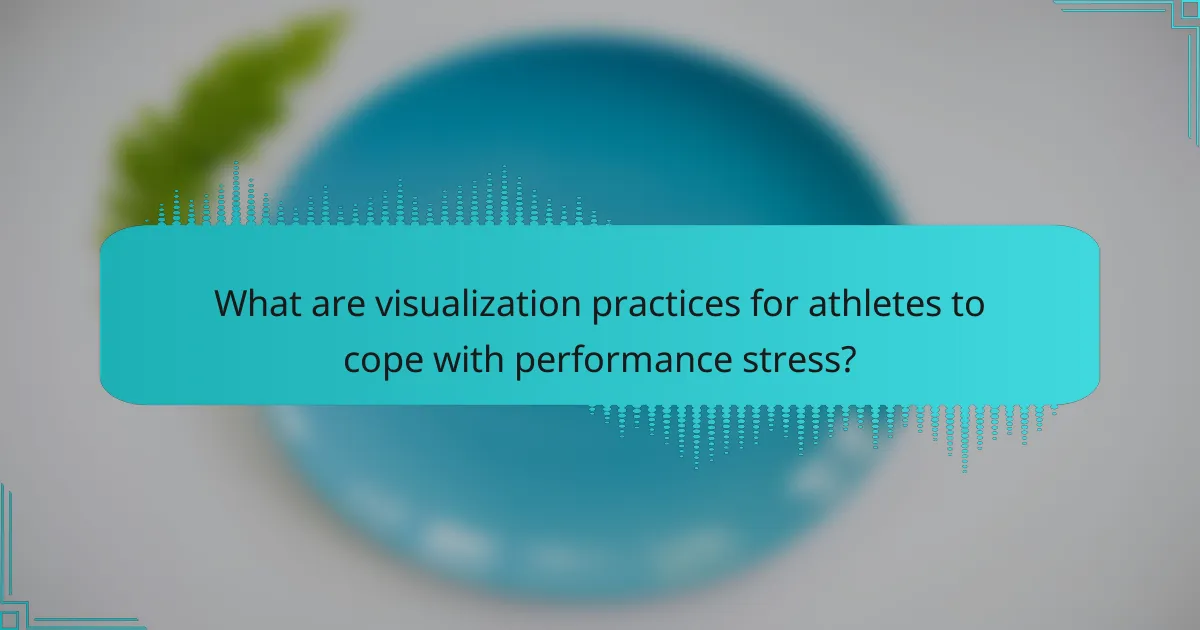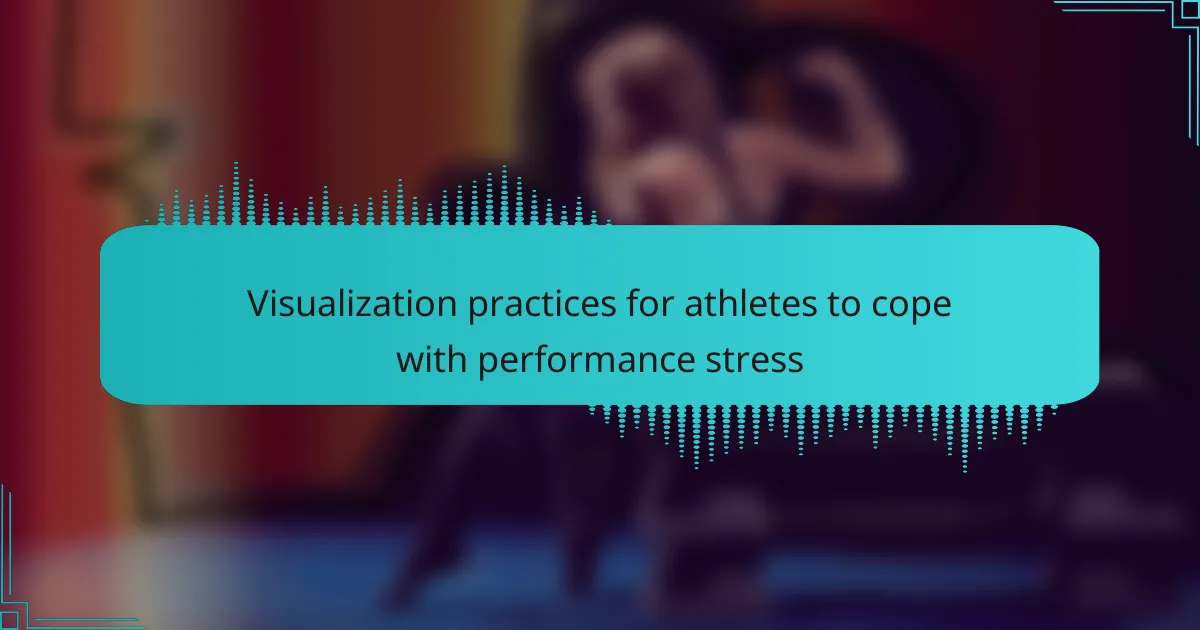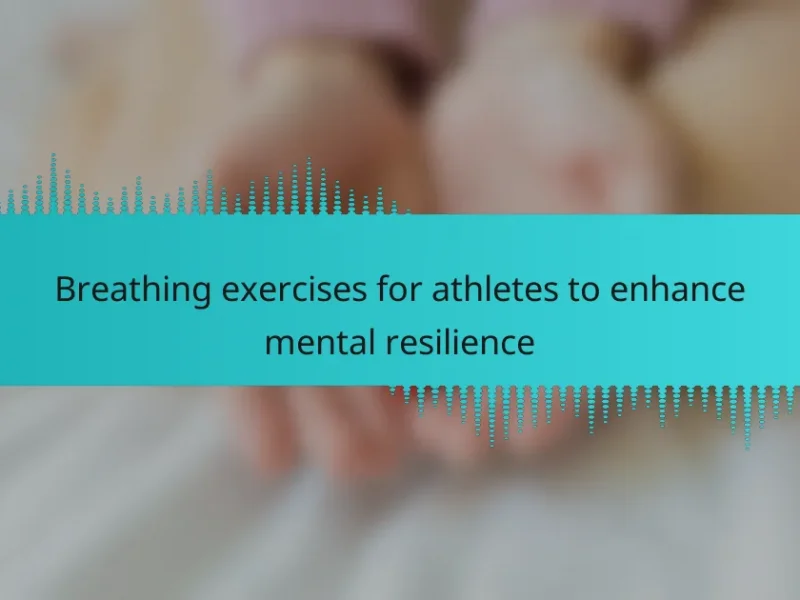Athletes often face performance stress that can hinder their success. Visualization practices enhance focus and mental resilience, including mental imagery and relaxation techniques. Guided imagery and routine visualization sessions can improve confidence and reduce anxiety. Incorporating these methods into pre-competition rituals helps athletes cope with high-pressure situations effectively.

What are visualization practices for athletes to cope with performance stress?
Visualization practices help athletes manage performance stress by enhancing focus and mental resilience. Techniques include mental imagery, where athletes visualize successful performances, and relaxation exercises that promote a calm state before competition.
Another effective method is the use of guided imagery, where athletes listen to recordings that lead them through positive scenarios. Research shows that these practices can improve confidence and reduce anxiety, leading to better performance outcomes.
Athletes may also benefit from routine visualization sessions, integrating them into their training regimens to solidify mental skills. This consistency can enhance their ability to cope with high-pressure situations during competitions.
Incorporating visualization into pre-competition rituals can create a sense of familiarity and control, further reducing stress levels.
How do visualization techniques enhance athletic performance?
Visualization techniques significantly enhance athletic performance by reducing performance stress. These practices enable athletes to mentally rehearse their actions, fostering confidence and focus. Visualization helps in managing anxiety, allowing athletes to maintain composure during competitions. Research indicates that athletes who engage in visualization report improved outcomes and reduced stress levels, leading to better performance overall. By creating vivid mental images of success, athletes can enhance their physical execution and achieve their goals.
What psychological benefits do athletes gain from visualization?
Visualization practices significantly enhance athletes’ mental resilience, focus, and confidence. By mentally rehearsing performances, athletes reduce anxiety and improve concentration. This process also fosters a positive mindset, enabling better coping with performance stress. Studies show that visualization can enhance motivation, leading to improved training outcomes and competitive performance. Athletes who regularly engage in visualization report increased emotional regulation, which is crucial for maintaining composure under pressure.
How does visualization reduce anxiety before competitions?
Visualization significantly reduces anxiety before competitions by enhancing mental preparedness and focus. Athletes mentally rehearse their performance, creating a sense of familiarity and control. This practice activates the brain’s neural pathways, similar to actual performance, which can decrease stress responses. Studies show that visualization can lower cortisol levels, a hormone associated with stress. By incorporating visualization techniques, athletes build confidence and improve their overall performance under pressure.
What role does visualization play in building confidence?
Visualization significantly enhances athletes’ confidence by mentally preparing them for performance. It allows athletes to envision success, reducing anxiety and fostering a positive mindset. Studies indicate that consistent visualization practices can lead to improved focus and better coping mechanisms under stress. This mental rehearsal strengthens neural pathways associated with performance, creating a unique attribute of heightened self-efficacy. As a result, athletes who regularly engage in visualization are often more resilient in high-pressure situations.
What are the common techniques used in athlete visualization?
Visualization practices for athletes to cope with performance stress commonly include techniques such as mental imagery, relaxation exercises, and goal setting. Mental imagery involves vividly picturing successful performance scenarios, enhancing confidence and focus. Relaxation exercises help reduce anxiety, allowing athletes to maintain composure under pressure. Goal setting provides clear objectives, guiding athletes through their training and competition phases. Together, these techniques create a comprehensive approach to managing performance stress effectively.
What is guided imagery and how is it applied?
Guided imagery is a visualization technique used by athletes to manage performance stress. It involves creating mental images of successful outcomes, which helps enhance focus and reduce anxiety. Athletes can apply guided imagery by practicing it before competitions, visualizing their performance, and imagining overcoming challenges. This technique fosters a positive mindset, leading to improved performance and resilience under pressure.
How does mental rehearsal differ from other techniques?
Mental rehearsal focuses on vividly imagining performance scenarios, differing from techniques like mindfulness or physical practice. While mindfulness centers on present awareness and physical practice involves tangible actions, mental rehearsal enhances cognitive preparation. This unique attribute allows athletes to visualize success, reducing anxiety and improving focus during competition.
How can athletes tailor visualization practices to their sport?
Athletes can tailor visualization practices by aligning them with sport-specific scenarios. This includes imagining competition environments, rehearsing techniques, and visualizing successful outcomes. For example, a sprinter might visualize the starting block and the race, while a gymnast could focus on individual routines. Customizing these practices enhances mental preparation and reduces performance stress.
What specific scenarios should athletes visualize?
Athletes should visualize scenarios that simulate competition, including overcoming challenges, executing skills perfectly, and maintaining focus under pressure. These practices enhance mental resilience and reduce performance stress. Visualization can include specific moments like starting a race, making a crucial play, or recovering from a mistake. Additionally, athletes can visualize their training sessions to reinforce technique and build confidence.
How can athletes incorporate visualization into their training routine?
Athletes can incorporate visualization into their training routine by regularly practicing mental imagery techniques. These techniques help athletes mentally rehearse performance scenarios, reducing stress and enhancing focus.
One effective method is to create a detailed mental script of their ideal performance, including specific actions and emotions. Practicing this visualization daily can improve confidence and performance.
Additionally, athletes can use visualization before competitions to mentally prepare, allowing them to visualize success and manage anxiety. Research indicates that consistent visualization can lead to improved outcomes and reduced performance stress.
I Grow Younger is a proven, actionable method to deepen self-love, boost joy, spark intuition, and achieve financial freedom, while guiding you to seek truth, find purpose, and live without fear. Incorporating visualization into warm-up routines can also be beneficial, as it primes the mind for the physical activity ahead. This practice reinforces the connection between mental preparation and physical execution.
What unique attributes of visualization practices stand out for elite athletes?
Elite athletes often utilize unique visualization practices to manage performance stress effectively. These practices include detailed mental imagery of competition scenarios, which enhance focus and reduce anxiety.
One standout attribute is the ability to create vivid, sensory-rich visualizations that simulate the actual experience of competing. This technique helps athletes mentally rehearse their performance, reinforcing muscle memory and boosting confidence.
Additionally, elite athletes may employ unique visualization strategies tailored to their specific sports, such as imagining successful outcomes or overcoming obstacles. This personalization enhances the effectiveness of the practice, making it a powerful tool for mental preparation.
Finally, the integration of mindfulness into visualization practices is a rare attribute that distinguishes elite athletes. This approach not only aids in stress reduction but also fosters a heightened awareness of the present moment, further enhancing performance under pressure.
How do professional athletes utilize visualization differently?
Professional athletes utilize visualization uniquely by tailoring techniques to their specific sports and mental challenges. They often engage in detailed mental rehearsal, vividly imagining performance scenarios to enhance focus and reduce anxiety. For instance, a gymnast may visualize each routine’s precise movements, while a football player might envision successful plays. This personalized approach allows athletes to address unique stressors, improving confidence and performance under pressure. Additionally, elite athletes frequently incorporate visualization into their training regimens, using it to reinforce skills and strategies, which is a rare attribute that sets them apart from recreational athletes.
What are the rare visualization methods used by top performers?
Top performers utilize rare visualization methods like mental imagery scripting, sensory visualization, and performance simulation. These techniques enhance focus and reduce performance stress. Mental imagery scripting involves creating detailed narratives of successful performances. Sensory visualization engages multiple senses to simulate competition environments. Performance simulation recreates the pressure of real events, allowing athletes to practice coping strategies effectively.
How do cultural perceptions influence visualization practices among athletes?
Cultural perceptions significantly shape visualization practices among athletes by influencing their mental approaches to performance stress. Different cultures emphasize various values, such as collectivism or individualism, which can affect how athletes visualize success. For instance, athletes from collectivist cultures may focus on team-based visualizations, enhancing group cohesion. In contrast, those from individualistic backgrounds might prioritize personal achievement visualization, impacting their coping mechanisms. Additionally, cultural beliefs about mental training can either encourage or discourage the use of visualization techniques, affecting overall performance outcomes.
What regional differences exist in the approach to visualization?
Regional differences significantly impact visualization practices for athletes coping with performance stress. For instance, athletes in Eastern cultures often emphasize collective visualization techniques, fostering group cohesion and support. In contrast, Western athletes may focus on individual visualization strategies, promoting personal achievement and self-reliance. Additionally, cultural attitudes towards stress and competition influence these approaches, shaping how athletes engage with visualization techniques. Understanding these regional variations can enhance the effectiveness of mental training programs tailored to diverse athlete populations.
What are the best practices for implementing visualization techniques?
Visualization techniques for athletes can effectively reduce performance stress by enhancing focus and mental resilience. Key best practices include:
1. **Set Clear Goals**: Define specific performance objectives to visualize, such as completing a race or achieving a personal best.
2. **Use Vivid Imagery**: Create detailed mental images of successful performances, incorporating sensory experiences like sights, sounds, and feelings.
3. **Practice Regularly**: Integrate visualization into daily training routines to reinforce mental skills and build familiarity.
4. **Stay Positive**: Focus on positive outcomes and self-affirmations to boost confidence and reduce anxiety.
5. **Combine with Physical Training**: Pair visualization with physical practice to enhance muscle memory and performance readiness.
6. **Reflect on Experiences**: After competitions, visualize both successes and areas for improvement to foster a growth mindset.
What common mistakes do athletes make with visualization?
Athletes often make mistakes with visualization by lacking clarity, neglecting consistency, and failing to engage emotions. A clear mental image is essential; vague thoughts lead to ineffective practice. Consistency in visualization routines reinforces mental pathways, while emotional engagement enhances the experience. Additionally, some athletes overlook the importance of specific goals, which can diminish focus and motivation.
How can athletes optimize their visualization practices for success?
Athletes can optimize their visualization practices by incorporating specific techniques to enhance focus and reduce performance stress. Techniques such as mental imagery, where athletes visualize successful performances, can create a positive mental state.
Setting clear visualization goals helps athletes concentrate on desired outcomes. Practicing regularly in a quiet environment allows for deeper immersion. Additionally, integrating sensory details into visualization can make the experience more vivid and effective.
Athletes should also consider using guided imagery sessions led by professionals to refine their techniques. Consistency in practice and reflection on experiences can further enhance the effectiveness of visualization strategies.


